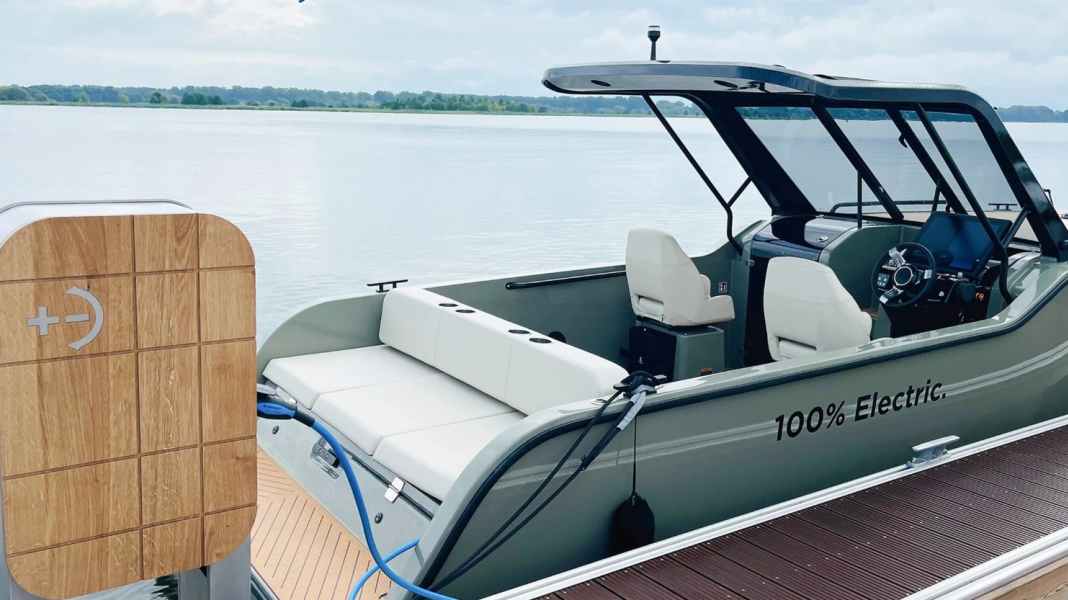
"The initiative to motivate boat owners to move away from fossil fuels makes sense if they know that they can find e-charging points within a feasible distance along the Wadden Sea coast of Lower Saxony from Leer to Brunsbüttel," says the Mellumrat e.V. website. The nature conservation and research organisation is one of the participants in the project, which aims to investigate the technical requirements for climate-neutral leisure shipping. The initiative is funded by the Federal Ministry of Transport.
More articles on the topic of e-mobility on the water:
A charging station for boats every 30 kilometres
According to the concept for the "electrification" of the port locations in the coastal region of Lower Saxony, a total of 21 charging stations at a maximum distance of 30 kilometres are required for a charging infrastructure chain of around 430 kilometres along the coast between the Ems and Elbe rivers.
The main aim of the project is to identify these locations and design a comprehensive charging network along the Wadden Sea coast of Lower Saxony and Hamburg. The locations identified will then be categorised and made available to potential users on a map. Project manager Lukas Hoppe from service provider GP Joule talks about the challenges involved in finding a location: "The locations must be protected from flooding and storm surges, they are predominantly subject to the influence of the tides and they also address different user groups, such as motorboat or sailing boat owners, commercial shipping in the harbour and the charging of private cars."
As demand from the sea will initially be low, the charging points in the harbours should be installed in such a way that they can also be used for cars at the same time in order to increase capacity utilisation. Most marinas already have power connections at the jetties. However, the lines are not designed for charging traction batteries. When it comes to charging with direct current, in many cases a mains connection extension is required. This is particularly important for larger boats or those that need to charge more quickly, such as water taxis.
E-mobility on the water: someone has to start
While the switch to electromobility on land is progressing slowly but steadily, very little has happened on the water so far. This is mainly due to the "chicken and egg problem", according to technical advisor Christian Bahlke from Mellumrat e.V.. "The water was forgotten during the whole electrification process," confirms Holger Wesemüller, Chairman of the Advisory Board for the Lower Saxony Wadden Sea National Park. In order to motivate boat owners to make the switch, someone needs to start building the necessary infrastructure.
According to Christian Bahlke, once the conditions for this have been created, there is really no argument against the switch for boat owners. After all, apart from the fact that an electric motor is environmentally friendly and climate-neutral when powered by renewable energy, they are also more convenient for boat owners. "You don't need to lug canisters of petrol around." E-engines also have a longer service life than diesel engines. Although they are more expensive to buy, the operating costs are around a third lower than the usual costs.
No funding from the state in sight
The first harbours and marinas have already signalled their interest in installing charging points for electric boats on the water - including the town of Leer and the coastal town of Neuharlingersiel in East Frisia. According to Wesemüller, many harbour operators would join in if the development of charging infrastructure were promoted. The initiators hope that the state of Lower Saxony - similar to Schleswig-Holstein - will initiate such funding. The neighbouring federal state makes no distinction in its funding as to whether it is a charging point for a car or a boat.
So far, however, there is no funding from the state in sight. "We welcome the planned electrification of leisure shipping on the coast of Lower Saxony [...] However, we currently see no prospect of support from the state," said the Lower Saxony Ministry of Economic Affairs with reference to the budget situation.
Other countries are leading the way
In Italy, Spain and Scandinavia, on the other hand, e-mobility on the water is already several steps ahead. More than 400 charging points for electric boats are to be created between Gothenburg and Kristiansand alone.
In a working group, those responsible for the project now want to work out what technical issues there are locally - and then set up the first charging station as soon as possible. "At the moment, our initiative extends from the Ems to the Elbe," said Bahlke. In the long term, however, the aim is to connect Dutch harbours and the Kiel Canal to the Baltic Sea. In view of the fact that the Wadden Sea neighbours Germany, Denmark and the Netherlands agreed back in 2010 to make the Wadden Sea region climate-neutral by 2030, the measures seem more than overdue. Mathias Heckroth, Managing Director of the Mellum Council, sees the project as an opportunity to set a precedent: "We are happy to take on a pioneering role in the trilateral Wadden Sea World Heritage Site and show that fossil-free mobility can be established in this challenging water sports area."

